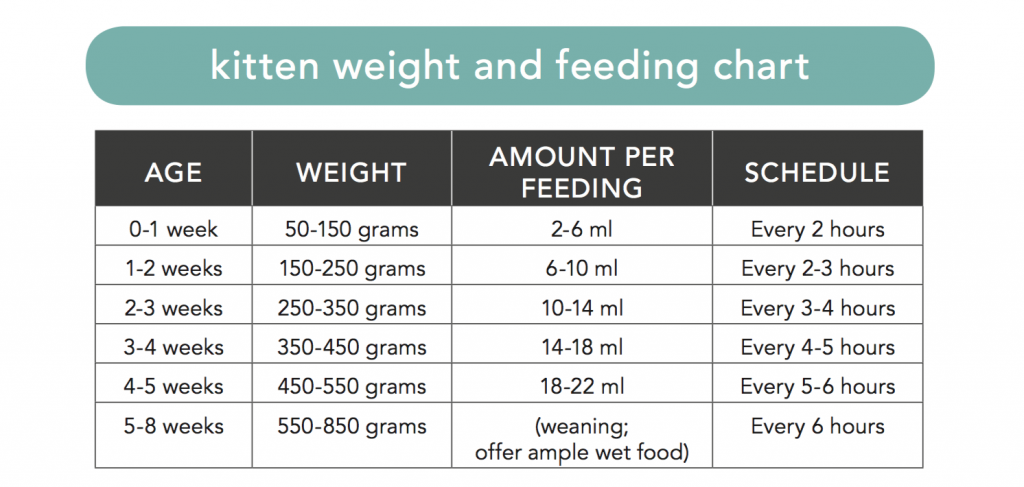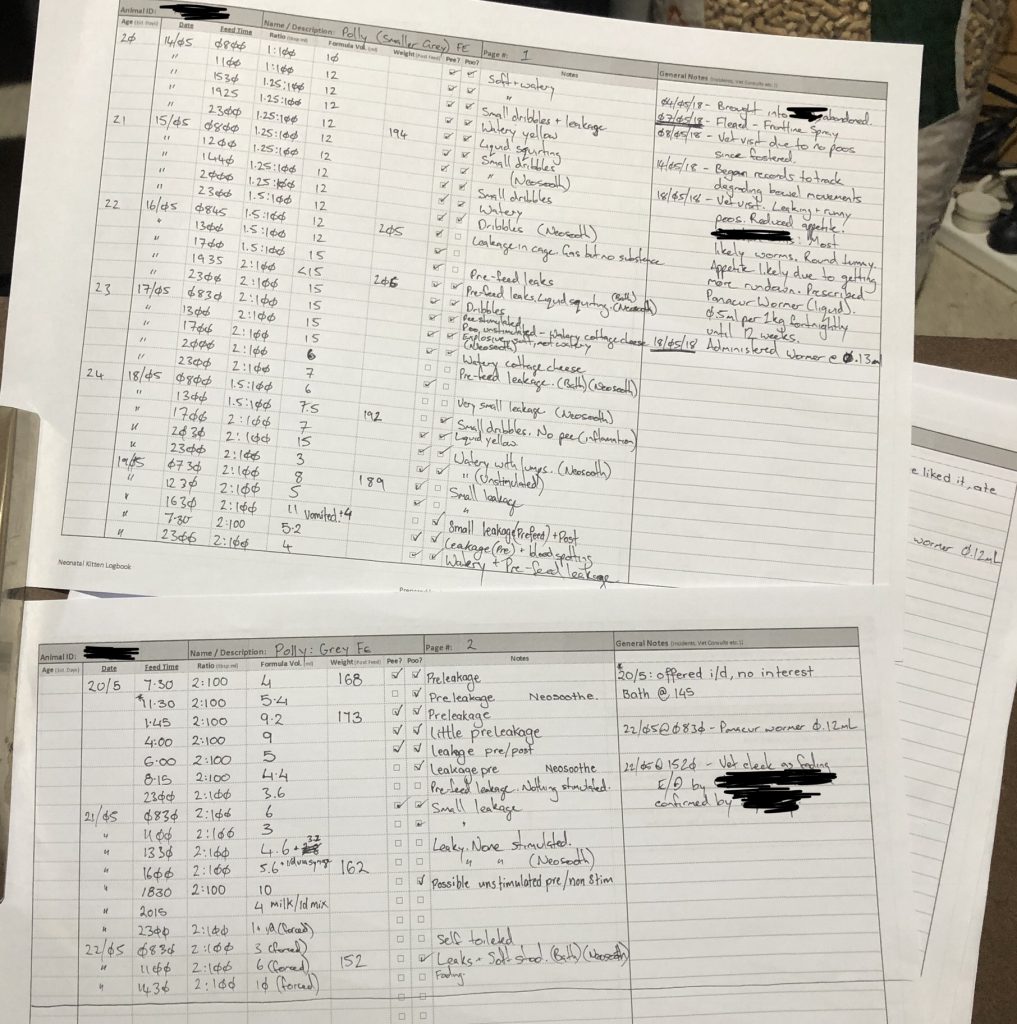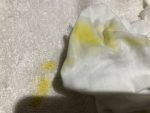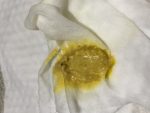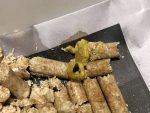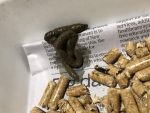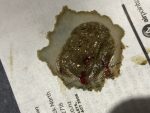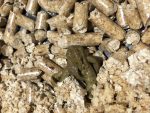A little over 3 weeks ago I took on the responsibility of fostering some neonatal kittens. They were handed into an animal shelter I volunteer at. Although I am familiar with looking after kittens and cats, these were the first neonatal ones I’d dealt with, so it’s been a learning curve and is still ongoing.
This was my first time with long-term care of neonatal kittens so while I had good experience with cats in general, there was, and is, still lots to learn. I wanted to share some of my learnings and experience with these kittens so far in the hope it might help others who end up in a similar situation.
The Story

Meet Polly, Tajia, Sheba and Dorian.
Four very young kittens were dumped without their mother, well before they should have been separated. None of the regular fosterers that have the experience and capability with neonatal kittens (they require a higher degree of care and time to survive) was available so their future looked bleak; I happened to be there that day and decided to take them on and give them at least a chance.
At this stage, we were starting with a low chance of survivability given the age they were separated from their mother. Their eyes were just open so but they still weren’t seeing much. I’ll discuss estimating age further down, but our best guess at that point was that they were a little under 2 weeks.
A couple of days after I took them on, we got them treated for fleas. A flea burden of even a handful can prove fatal for kittens; they drink the blood leading to anemia among other issues so a simple step is very important.
After 3 days none of them had pooed. Given they were on formula I wasn’t expecting much and certainly not anything too solid with the change in diet, but I expected something! After consulting with the shelter I was off to the vet the next day to get them checked out for constipation, and after a thermometer where no one would like one, they started toileting!
And then came the diarrhoea.
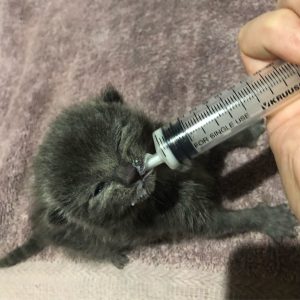 Diarrhoea is another huge risk for kittens, especially the very tiny ones. There isn’t much to them, so dehydration can set in quick and has a high chance of fatality. 2 of my kittens in particular basically had a bit of constant leakage. They were still happy enough and eating, but when their appetite started to decline we were off to the vet again.
Diarrhoea is another huge risk for kittens, especially the very tiny ones. There isn’t much to them, so dehydration can set in quick and has a high chance of fatality. 2 of my kittens in particular basically had a bit of constant leakage. They were still happy enough and eating, but when their appetite started to decline we were off to the vet again.
Since I’d gotten them, there had been no appreciable weight gain despite a reasonable appetite and feeding schedule. Putting the whole story together with the vet, our prevailing theory was likely parasitic burden (worms) which accounted for the initial lack of weight gain; and now the kittens were starting to feel unwell which had led to not wanting to eat.
So a dose of wormer and hopefully some improvement would be seen. I also increased the frequency of feeds from 4 hourly to between 2 and 2.5 hourly to combat dehydration.
That was Friday, by the following Tuesday there had been some blood in their poos (expected after worming), but all signs still pointed to the worms still having a fair hold so another dose of wormer to start the day. 3 out of 4 of the kittens were active and causing havoc although not yet gaining any appreciable weight.
But that leaves 1.
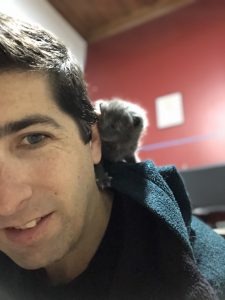 Since Monday night, one of the kittens (Polly) had been reluctant to take food, so she has basically been force fed to keep some fluids on board. When I went to feed at 14:30 the next day I had to search the crate to find her. She was curled up next to the hot water bottle, having crawled under the bedding so she was right beside it.
Since Monday night, one of the kittens (Polly) had been reluctant to take food, so she has basically been force fed to keep some fluids on board. When I went to feed at 14:30 the next day I had to search the crate to find her. She was curled up next to the hot water bottle, having crawled under the bedding so she was right beside it.
She was limp, and at first, I thought she had already passed, but she was still alive. I wrapped her in a blanket and she reluctantly accepted formula, but while there was movement in her head, her body remained limp. It wasn’t looking promising, but I decided that a trip to the vet was required, either if she was going to have a chance at coming back from the brink or to end her suffering.
Sadly it was the latter. It’s upsetting to have had it end this way as it’s natural to get some attachment to the little fluff balls. It’s also hard wondering if you’d done anything differently if the outcome may have been different also.
The hardest part of fostering neonates.
In the end, their chances of survival weren’t high to start with. And actually, as a fosterer it’s important to concentrate on the fact that she had a chance she wouldn’t otherwise have had; not to mention the other 3 that are (fingers crossed) doing well.
We’re now on Sunday after the loss of Polly and the other three are doing okay. Dorian is putting on weight and proving to be a little hungry sod; the other two are holding their weight and only just starting to make small gains. We’re also starting to see some better-formed poo, and they are getting the idea of the litter tray more often.
I’ve started offering them wet food and biscuits, along with a bowl of water. 2 of them love the wet food and Dorian (shock) is the first to show some interest in the biscuits. The water is getting more use for play than drink, but they will get the hang of it. I’m still supplementing with formula to help keep good nutrition and hydration as they gradually transition over to the other foods more significantly.
Helpful bits and pieces
Here are some random notes and links that I put together while researching and learning. They might be useful to someone else, but my disclaimer is that I have no training in this area so these notes are my own interpretation and options of what I’ve researched.
The advice from your shelter or a vet should always trump anything I say here, and if in doubt you should always ask them if you’re unsure about anything.
Estimating the age of kittens
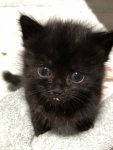
Sheba
There are many websites that will tell you how to estimate a kittens age, based on various development factors. The first thing I learned, is that many of them disagree to some extent, and even those that agree have a margin of error.
The 4 kittens I had had certain development inconsistencies which led me around in circles; one guide would tell me that based on their eyes they were 14 days, but based on their ears they were 5 days… Not so helpful, and it took me a while to come to a consensus.
Eyes
As best I can tell, a kitten’s eyes can open anywhere from around 5 – 14 days depending on who you ask or where you read. Based on conversations with a couple of local vets, expect fully open eyes to be around 10-14 days, but if it seems earlier, don’t be too shocked.
Ears
What I read suggests ears are unfolded by around 3 weeks. My critters took longer, so that threw me a little. Also, different breeds vary apparently, so this is a hard one to get a good measure on.
Teeth
While most things have a wide variability depending on things like health, breed etc. my understanding is that teeth are one of the better tells. While there is probably some variance for certain breeds, overall teeth seem to have one of the more reliable tells.
A kitten’s baby teeth develop starting with the incisors, middle to outer with upper and lower likely coming through matching. Then comes canines, and then pre-molars. The order is reliably predictable and over a certain period of development time are a great marker.
If you are trying to predict age during the period their teeth develop, I’d go with them as the main guide. Obviously, if you have them before they have any teeth, or after they have gotten all their teeth, that reduces what time period you can estimate.
The best resource I found on teeth was http://princetonvet.net/age-cat-by-its-teeth/.
Feeding and Weight
While trying to establish how much these guys should be eating, I came across a wide range of feeding charts.
Based on age, I found my kittens rated as underweight for all of them This isn’t uncommon for orphaned/abandoned kittens especially early in life.
As for how much to feed them, I couldn’t find much agreement, however, I landed on 6-10mL for 2 weeks old. Around 3+ weeks we moved up to around 15mL from there, at a 4-hour feeding interval. This was based on advice from my shelter, so ask them or a vet if you’re unsure.
Vets can also make a much better estimate of age to be able to guide to safe and required feeding amounts. Depending on what formula you’re using, they will often have good guides on the packet in lieu of any other guidance (I’m using Milligans Multi-milk replacer).
I syringe fed as I find it easier when they aren’t used to formula feeding. I also got a hold of a “Miracle Nipple” which gave the best part of the bottle feeding also. Using the syringe made it easy to track how much they were eating, and the nipple made it easier for them to suckle.
I used the following table from http://www.kittenlady.org/ as a guide for what weights would be “ideal” for their age.
Overfeeding
Overfeeding can lead to diarrhoea which as mentioned above is a problem, and kittens won’t always just stop when they have had enough so early on the 10mL was a hard limit. As they grew I would stop when they started to lose interest even though if prompted they would continue feeding. I’ve also read that overfeeding could lead to greater health decline and death in some circumstances.
When I decreased the time between feeds to combat dehydration I accordingly didn’t expect as much to be eaten each feed, so timing plays a part also.
As I mentioned above, I’m now also offering wet food (currently i/d food to help settle the diarrhoea which is working well but eventually onto standard kitten food), and dry kitten biscuits. I’ve put water in there as well so that they have the opportunity to make up fluids they don’t get in dry food. In the meantime feeds of formula are still important as this needs to be a transition, not a switch.
Gradually they will transition more to the wet and dry foods, and the need for formula will stop altogether.
Record keeping – The Kitten Logbook
I was a little slow off the bat with keeping records. When the kittens started having issues with diarrhoea, I realised I needed to keep better notes of what was happening. My memory only covered so much!
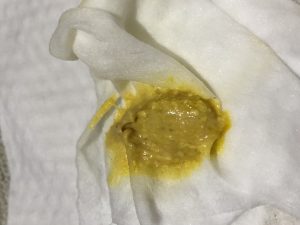
I needed to record how much they were eating, what their toileting was like, and each time I weighed them. I found some templates online but none covered the things I was specifically after. So I made one up myself. You can grab a copy of my Kitten Logbook template for yourself if you need one or just want to try mine.
Besides helping me track kitten progress, it was really useful to be able to take with me to the vet. Memory is fallible, and details are important. Particularly, as much of a messy topic as it is, notes on their toileting; descriptions of colour and texture of faeces.
Below you can see a picture of some of my completed forms to get an idea how I used them.
The document is designed to be printed 2-sided with short edge binding, giving more room for notes on the back, but that space may change. Some things like Animal ID may not be relevant to you depending on the shelter you’re working with; for me, these are the ID’s that are used to identify the kitten with the shelter records especially for vet visits.
The main design may change a little too as I’m now starting to wean them off formula, which changes the sort of information that can be recorded (or that it’s useful to record). As I get more experience in this phase I may adapt the design. Regardless, I’ll share whatever I come up with.
Poo
Not a favourite topic for most, but one that can tell you a lot about the health of your kitten.
I found that there was a fair amount of information online, but most of it just descriptions, or illustrated colouring. So I wanted to add some photos here so you could see some of the things you might expect.
It’s by no means a comprehensive collection of even the types I saw, but I wasn’t always taking pictures! The more yellow poo is common colouring for formula fed kittens and gets darker when they start eating wet food.
- Water, formula fed poo
- Soft/runny, formula fed poo
- Formed, formula fed poo
- Formed poo
- Formed poo
- Slightly mucous poo
- Formed poo
- Slightly mucous poo
- Formed poo
Note that the “Formed, formula fed poo” wasn’t one I saw often. When formed, the formula based ones were normally thicker and looked like the consistency of toothpaste.
Some of the darker ones have blood flecks in them too but that was expected due to recent de-worming. If you haven’t recently wormed or you’re unsure, blood in the stool should be something to seek advice for.
Also, remember that while they are young you have to stimulate them to toilet. At 5 weeks mine are toileting themselves but I am still stimulating after feeding to ensure they are ALL getting everything out okay, and regularly at least one of them will let more out. I’ll be stopping this soon but be sure to make sure all of yours are self-toileting before you abandon this step.
Thanks
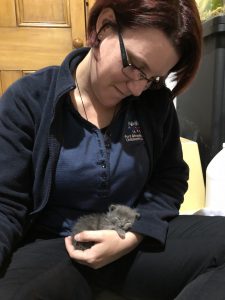 It has to be added. I want to say a huge thanks to the staff at the Napier & Hawke’s Bay branch of the SPCA for their help and support, and putting up with my often stupid questions. You guys are awesome and do a bloody great job!
It has to be added. I want to say a huge thanks to the staff at the Napier & Hawke’s Bay branch of the SPCA for their help and support, and putting up with my often stupid questions. You guys are awesome and do a bloody great job!
Also thanks has to go to my partner who took the unexpected arrival in her stride, and who has helped do feeds while I’ve been stuck at training or on callouts.
Other Links
These are some other links I came across giving info on development and health of kittens and other useful resources. I’ll update more if I come across some other good ones. Remember, results may vary and always seek advice from a shelter or vet.
Development timelines
General / Other
- https://gentlepawspetsitting.com/kitten-primer/
- http://www.kittenlady.org/ – The kitten lady is pretty awesome and has some great youtube clips.
Toilet Business
- http://kittencoalition.org/wp-content/uploads/2017/05/NKC-Fast-Facts_Poop-Chart_5-2017.pdf
- http://www.kittenbaby.com/bowel-movement.php
